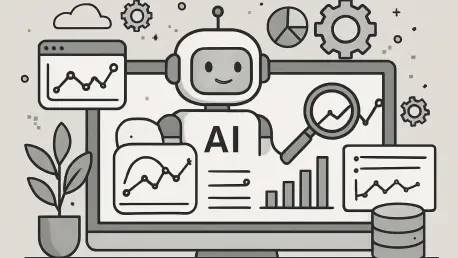In the fast-paced realm of artificial intelligence (AI), where autonomous agents are transforming industries by handling complex tasks like customer support and data analysis, the concept of agent observability has become a linchpin for ensuring reliability and performance. As businesses integrate these AI agents—powered by large language models (LLMs)—into critical operations, the ability to peer into their inner workings is no longer a luxury but a necessity. Agent observability provides that crucial visibility, enabling teams to monitor inputs, outputs, and decision-making processes, thereby identifying issues before they escalate. This article delves into the multifaceted world of agent observability, unpacking its definition, core components, business impacts, and the challenges of implementation, while offering practical insights drawn from real-world applications. With AI agents increasingly driving efficiency across sectors, understanding how to maintain their trustworthiness through observability is paramount for any organization aiming to leverage this technology effectively.
The unpredictable nature of AI systems adds a layer of complexity that traditional monitoring cannot address, making performance assessment a unique challenge. Unlike conventional software with predictable outcomes, AI agents often produce varied results even with identical inputs. Observability steps in as a vital tool to track every stage of an agent’s lifecycle, from receiving a query to delivering a response, ensuring that errors, bottlenecks, or misleading outputs—such as hallucinations—are caught early. This transparency not only builds trust in AI deployments but also safeguards operational integrity. As industries continue to adopt these systems at an unprecedented rate, with projections indicating widespread integration of observability solutions among companies using LLMs, the focus on maintaining agent reliability has never been more critical.
The Foundations of Agent Observability
Defining the Concept
Agent observability centers on the ability to monitor and understand the behavior of AI agents that operate autonomously, using tools and resources in iterative loops to achieve specific objectives. These agents, often built on large language models (LLMs), execute multi-step tasks—such as a customer support bot retrieving transaction data, analyzing refund policies, and crafting tailored responses. Observability in this context means gaining deep insights into the inputs that trigger actions, the internal processes that guide decisions, and the outputs delivered to users. This differs from broader AI monitoring by focusing specifically on agents’ unique, repetitive workflows. By dissecting each interaction, observability transforms what might seem like a black box into a transparent system where performance can be tracked and optimized, ensuring that these agents align with intended goals.
This concept also draws distinctions from related terms like AI observability or GenAI observability, though the core idea remains consistent: ensuring reliability through visibility. The non-deterministic nature of LLMs, where identical prompts can yield different responses, necessitates a specialized approach to monitoring and analysis. Observability tools capture detailed data on every interaction, allowing teams to pinpoint where and why deviations occur. Whether it’s a subtle shift in tone or a factual inaccuracy, having a clear view of an agent’s decision path is essential for troubleshooting. As more organizations deploy agents in production environments, this granular understanding becomes the foundation for scaling AI solutions without compromising on quality or user trust.
Why It Matters in AI Systems
The significance of agent observability in AI systems cannot be overstated, especially as these agents take on critical roles in business operations ranging from automating customer inquiries to processing vast datasets. Without observability, the inherent unpredictability of non-deterministic AI could lead to unnoticed failures—think of a support agent providing incorrect information or a data analysis tool misinterpreting trends. Such errors erode confidence and disrupt workflows, potentially costing organizations both financially and reputationally. Observability acts as a safeguard, offering real-time insights into performance metrics and enabling rapid response to issues. This capability ensures that AI agents remain dependable, even under the strain of complex, high-stakes tasks.
Beyond immediate problem-solving, observability supports long-term system improvement by revealing patterns in agent behavior that might otherwise go undetected, ensuring that subtle issues are identified and addressed before they escalate. For instance, consistent latency in responses or recurring inaccuracies in outputs can signal deeper configuration issues or training data gaps. Addressing these through observability-driven insights helps refine agent capabilities, much like tuning an engine for optimal performance. As AI adoption grows, with projections suggesting that most companies using LLMs will integrate observability solutions, the emphasis on maintaining uptime and minimizing risks becomes a strategic priority. This approach not only protects current operations but also paves the way for scaling AI initiatives with confidence across diverse industries.
Components and Mechanisms of Observability
Trace Visualization for Transparency
Trace visualization stands as a cornerstone of agent observability, providing a detailed map of an agent’s actions throughout its operational cycle, and by leveraging frameworks like OpenTelemetry, this mechanism captures telemetry data—think model versions, token counts, and latency metrics—for every step, or span, in an agent’s workflow. This data is often aggregated into a data warehouse or lakehouse for analysis, turning complex interactions into clear, actionable insights. For example, in a customer support scenario, trace visualization might reveal the exact prompts used, the context retrieved, and the resulting output at each stage. Such transparency is invaluable for diagnosing issues, whether it’s a delay in response or an unexpected deviation in content, allowing teams to address root causes with precision.
The power of trace visualization lies in its ability to demystify the often opaque decision-making processes of AI agents, allowing teams to understand and address issues with precision. Instead of guessing why an agent failed to meet expectations, teams can follow a breadcrumb trail of data to identify specific pain points. This might include uncovering a bottleneck in data retrieval or spotting a misstep in reasoning logic. By presenting this information in an accessible format, often through dashboards or analytical tools, trace visualization empowers organizations to move beyond reactive fixes to proactive optimization. As AI systems grow in complexity, with agents interacting with multiple tools and sub-agents, this level of detailed oversight ensures that no aspect of performance remains hidden, fostering trust in automated solutions.
Evaluation Monitors for Quality Assessment
Evaluation monitors play a pivotal role in agent observability by assessing the quality and effectiveness of an agent’s outputs, ensuring they meet predefined standards. These monitors come in two primary forms: AI-based evaluations, often referred to as LLM-as-judge, and code-based monitors. The former excels in gauging subjective aspects like the helpfulness or relevance of a response, while the latter is ideal for objective metrics such as latency or adherence to strict formats, like ensuring a generated address matches US postal standards. A key best practice is prioritizing code-based monitors for their predictability and cost-effectiveness, as they avoid the variability and expense often associated with AI-driven assessments, providing a reliable baseline for performance tracking.
However, evaluation monitors must navigate the pitfalls of outdated or overly simplistic metrics that fail to capture the nuances of AI outputs, ensuring that assessments are meaningful and relevant to real-world applications. Traditional measures like ROUGE or BLEU, originally designed for machine translation, often produce misleading results by focusing on surface-level similarities rather than semantic meaning. Modern approaches, therefore, emphasize tailored metrics that align with specific use cases, ensuring evaluations reflect true user value. For instance, a customer support agent might be judged on response clarity and factual accuracy rather than mere word overlap. By refining how performance is measured, evaluation monitors help teams maintain high standards, catching issues like irrelevant outputs or delays before they impact end users, thus safeguarding operational integrity.
The Role of Context Engineering
Context engineering emerges as a critical, though often under-discussed, element of agent observability, highlighting the deep connection between data quality and agent performance. AI agents rely heavily on input data—such as vector embeddings, lookup tables, or retrieved documents—to inform their reasoning and outputs. If this context is incomplete, outdated, or incorrect, even a well-designed agent can falter, producing irrelevant or erroneous results. Observability in this sphere extends beyond the agent itself to monitor the upstream data pipelines that feed it, ensuring the integrity and availability of these inputs. This overlap with data observability underscores that agent reliability is only as strong as the information it processes.
Addressing context-related issues requires a holistic view of the AI ecosystem, where data health is continuously assessed alongside agent behavior to ensure optimal performance. For example, a sudden drop in response quality might trace back to a schema change in a database rather than an agent flaw. By integrating data monitoring into observability practices, teams can preempt failures caused by upstream disruptions, maintaining seamless operation. This dual focus also aids in optimizing context retrieval mechanisms, ensuring agents access the most relevant information efficiently. As AI systems scale, incorporating context engineering into observability frameworks becomes essential to prevent cascading errors, reinforcing the need for comprehensive visibility across all layers of the technology stack.
Benefits and Business Impact
Driving Reliability and Reducing Downtime
Agent observability directly contributes to the reliability of AI systems by minimizing downtime, ensuring that agents consistently deliver value to users across diverse applications. Downtime, often measured as the proportion of unsuccessful requests, can stem from technical glitches, irrelevant outputs, or delays in processing. Observability tools provide the means to detect and address these issues swiftly, whether through real-time alerts or post-interaction analysis. Real-world examples, such as Dropbox tracking agent responses for missing citations or high latency, illustrate how customized metrics help maintain performance standards. This focus on uptime translates into sustained user satisfaction, as agents fulfill their roles without unexpected interruptions.
Moreover, reducing downtime through observability has a ripple effect on operational efficiency, preventing minor issues from escalating into major disruptions that could harm the system. When an agent fails silently—perhaps by providing a subtly incorrect answer—it can erode trust over time, impacting customer retention or decision-making accuracy. Observability acts as a proactive shield, identifying patterns of failure before they become systemic. By correlating performance data with user feedback, teams can refine agent behavior to align with expectations, ensuring consistent reliability. This capability is especially crucial in high-stakes environments like healthcare or finance, where agent errors can have significant consequences, making observability a linchpin for operational success.
Enhancing Business Value
The business value of agent observability extends far beyond technical reliability, manifesting in measurable outcomes like cost reduction, revenue growth, and risk mitigation. By ensuring agents operate at peak efficiency, observability helps organizations save on resources that would otherwise be spent on manual interventions or damage control after failures. For instance, a pharmaceutical company leveraged observability to monitor an agent tasked with enriching customer records. Though the initial goal was to reduce human workload, the improved data quality led to unexpected operational gains, showcasing how observability can uncover hidden benefits. These efficiencies often translate into direct financial savings, bolstering the bottom line.
Additionally, observability supports revenue growth by enhancing user experiences through reliable AI interactions. When agents perform consistently—whether answering customer queries or automating internal processes—trust in the system grows, encouraging broader adoption and engagement. This reliability can also mitigate risks, preventing costly errors or compliance issues that might arise from unmonitored agent outputs. As metrics evolve from simple adoption rates to nuanced indicators like relevancy and factual accuracy, businesses gain deeper insights into how agents drive value. This data-driven approach ensures that AI investments yield tangible returns, positioning observability as a strategic asset in competitive markets where efficiency and trust are paramount.
Challenges in Implementation
Managing Evaluation Costs
Implementing agent observability often encounters the significant hurdle of evaluation costs, particularly given the resource-intensive nature of assessing multiple LLM calls within a single agent session. Each interaction may require analysis across various dimensions—such as accuracy, helpfulness, and latency—driving up expenses rapidly. Insights from data leaders reveal that evaluation costs can sometimes exceed baseline workloads by a factor of ten, posing a barrier for organizations with tight budgets. To counter this, strategies like stratified sampling, where only a subset of interactions is evaluated, offer a way to maintain insight without exhaustive expenditure. This approach prioritizes high-impact or high-risk sessions for detailed scrutiny, balancing cost with coverage.
Another tactic to manage costs involves filtering spans to focus on specific interactions that are most likely to reveal critical issues, rather than evaluating every step indiscriminately. This targeted method ensures that resources are allocated efficiently, preserving the depth of analysis where it matters most. Additionally, leveraging code-based monitors over AI-driven evaluations can further reduce expenses, as they provide deterministic results without the recurring costs of LLM calls. By adopting these cost-conscious practices, teams can sustain robust observability frameworks without straining financial resources, ensuring that the pursuit of reliability remains feasible even for organizations scaling AI deployments on limited budgets.
Defining Failure and Alerts
Defining what constitutes failure in agent performance, and subsequently setting appropriate alert conditions, presents a nuanced challenge due to the subjective nature of user expectations and diverse use cases. A response rated moderately for clarity might be acceptable in a casual chatbot but deemed a failure in a legal or medical context where precision is non-negotiable. This variability complicates the establishment of universal thresholds for alerts, as what signals a critical issue in one scenario may be a minor deviation in another. Best practices suggest aggregating multiple evaluation dimensions—such as helpfulness, accuracy, and relevance—into composite scores to provide a more holistic view of performance, reducing the risk of overreacting to isolated metrics.
Further complexity arises in distinguishing between immediate, actionable failures that require urgent alerts and softer issues that warrant review without halting operations. Anomaly detection plays a crucial role here, identifying consistent drops in performance over time rather than flagging one-off anomalies that may not indicate systemic problems. This method helps teams focus on trends that truly impact user experience, avoiding alert fatigue from excessive notifications. By tailoring failure definitions to specific business needs and user contexts, and refining alert mechanisms through continuous feedback, organizations can ensure that observability systems highlight the most pressing concerns, enabling efficient resource allocation and maintaining trust in AI outputs.
Addressing Flaky Evaluations
Flaky evaluations, where LLM-based judges produce inconsistent or unreliable results, pose a significant obstacle to effective agent observability, often undermining confidence in performance assessments. These inconsistencies can stem from the evaluators themselves hallucinating or being overly sensitive to minor prompt variations, leading to erratic scoring that doesn’t reflect true agent quality. Such variability can mislead teams into addressing nonexistent issues or overlooking genuine problems, wasting time and resources. To mitigate this, rigorous testing in staging environments using golden datasets—pre-validated examples of expected inputs and outputs—helps calibrate evaluation systems before they are deployed in live settings, ensuring greater reliability.
Beyond pre-deployment testing, incorporating human oversight during initial production runs adds a layer of validation to catch evaluator errors that automated systems might miss. Another practical solution involves automatically re-running evaluations for interactions that receive low scores, confirming whether the result indicates a real agent failure or an artifact of evaluator inconsistency. These steps help filter out noise, focusing attention on verified issues. By combining these strategies, teams can build trust in their evaluation processes, ensuring that observability efforts accurately reflect agent performance. This diligence is especially critical as AI systems scale, where unchecked flaky evaluations could compound errors across thousands of interactions, derailing reliability goals.
Achieving End-to-End Visibility
Achieving end-to-end visibility across the entire AI and data lifecycle remains a formidable challenge in agent observability, given the intricate interdependencies between data, systems, code, and models. Failures can originate from diverse sources—such as input data drift, pipeline disruptions, or model updates—making it difficult to isolate root causes without a comprehensive view. For instance, a drop in response relevancy might trace back to an upstream schema change rather than an agent issue. Without unified monitoring, teams risk chasing symptoms rather than solving underlying problems, which can prolong downtime. Consolidating telemetry data into a single source of truth, often a data warehouse, enables correlation of disparate signals, streamlining diagnosis across the stack.
This unified approach to visibility also accelerates root cause analysis by providing a clear line of sight from input to output, ensuring that issues can be traced efficiently across the entire system. When telemetry spans the full lifecycle, teams can quickly link a performance dip to its origin, whether it’s a flawed data update or a model retraining glitch. Such clarity is essential in distributed systems where agents interact with multiple components, each a potential failure point. Furthermore, end-to-end observability supports proactive maintenance by highlighting trends—like gradual data quality erosion—that might not trigger immediate alerts but could lead to future issues. By investing in integrated monitoring platforms, organizations ensure that no part of the AI ecosystem remains a blind spot, fortifying reliability in complex production environments.
Best Practices and Real-World Applications
Practical Strategies for Success
Navigating the complexities of agent observability demands actionable strategies that balance thoroughness with practicality, ensuring sustainable implementation across diverse AI deployments. One key practice is cost management through stratified sampling and targeted span filtering, which prioritizes the analysis of critical interactions over the exhaustive evaluation of every session. This approach maintains depth of insight while keeping expenses in check, a crucial consideration for scaling operations. Additionally, defining failure through composite scoring—combining metrics like accuracy and latency into a single assessment—offers a nuanced view of performance, preventing knee-jerk reactions to isolated data points. These methods help teams allocate resources effectively, focusing on high-impact areas.
Another vital strategy involves addressing evaluation reliability by conducting extensive staging tests before full deployment, using curated datasets to validate assessment accuracy. Human-in-the-loop validation during early production phases further refines this process, catching inconsistencies that automated systems might overlook. Equally important is consolidating telemetry across the data-AI lifecycle into a centralized platform, enhancing visibility and troubleshooting speed. This unified perspective ensures that issues, whether stemming from data inputs or agent logic, are traced efficiently. By adopting these best practices, organizations can build robust observability frameworks that adapt to evolving challenges, ensuring AI agents deliver consistent value without draining resources or trust.
Learning from Real-World Cases
Real-world applications of agent observability provide valuable lessons on tailoring solutions to specific business needs, demonstrating the flexibility and impact of customized approaches. Dropbox, for instance, employs dashboards to track evaluation scores over various time intervals, enabling timely detection of performance trends such as response latency or missing citations. These visual tools allow teams to monitor agent health at a glance, ensuring issues are addressed before they affect users. By focusing on metrics aligned with user satisfaction, Dropbox showcases how observability can be directly tied to operational goals, offering a model for other organizations seeking to balance technical monitoring with practical outcomes in customer-facing applications.
Similarly, Monte Carlo’s approach to observability emphasizes a composite evaluation framework for internal agents, assessing factors like semantic distance and tool usage on a standardized scale. This method integrates multiple performance indicators into a cohesive score, providing a clear benchmark for reliability across diverse tasks. Such tailored metrics highlight the importance of aligning observability with specific use cases, ensuring that assessments reflect true business value rather than generic standards. These examples underscore a broader principle: successful observability hinges on adaptability, where strategies are shaped by unique user expectations and organizational priorities, paving the way for scalable, effective AI integration across industries.
Technical Insights into Observability Architecture
Inside a Scalable AI System
Delving into the technical underpinnings of agent observability reveals how architecture design supports scalability and performance monitoring in complex AI environments, as exemplified by Monte Carlo’s Troubleshooting Agent setup. Hosted on Amazon ECS Fargate for containerized microservices, this system ensures flexible scaling through isolated, manageable components. Traffic is routed via a network load balancer to minimize latency, optimizing user experience even under high demand. The agent’s workflow involves sub-agents investigating distinct signals to pinpoint root causes of data quality incidents, then reporting findings to a central managing agent for cohesive presentation. This distributed, multi-agent structure highlights the necessity of observability tools that span intricate systems to capture comprehensive performance data.
The architecture’s reliance on detailed telemetry underscores the role of trace visualization in dissecting each interaction across sub-agents, ensuring no step is overlooked. Evaluation monitors further complement this by assessing output quality at every level, from individual sub-agent contributions to the final synthesized response. Such granularity is critical in distributed setups where failures can cascade through interconnected components, amplifying impact. By embedding observability into the system’s core design, Monte Carlo ensures rapid issue detection and resolution, maintaining reliability as complexity grows. This technical blueprint offers a glimpse into how observability integrates with modern AI infrastructure, providing a scalable model for organizations tackling similar multi-layered challenges.
Building Blocks for Robust Monitoring
Beyond specific architectures, the broader building blocks of observability infrastructure focus on creating adaptable, robust monitoring systems that support diverse AI agent deployments. Central to this is the use of standardized frameworks like OpenTelemetry, which provide a consistent method for capturing and structuring telemetry data across varied environments. This standardization allows seamless integration and monitoring across different platforms and systems.









